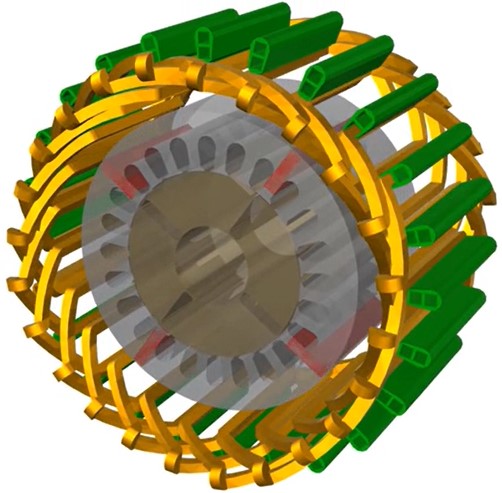Design Elements
|
Challenges in the Automotive Industry
|
Simulation Benefits in Automotive
|
Aerodynamics
|
- Resolve pressure distribution around the vehicle
- Minimize vehicle drag (to improve fuel economy)
- Assess vehicle handling and stability (side forces, lift)
|
- High-end turbulence models
- Sophisticated and accurate numerics
- Highly efficient transient solvers
- Mesh-adapt-on-the-fly ability
- Industry-leading parallel scalability
|
Automotive Acoustics
|
- Noise propagation for external and internal flows
- Qualify acoustic sources
- Determine dominant frequencies and sound pressure level (SPL)
- Understand effect of modifications to local geometric features on SPL and frequency
|
- High-end turbulence models
- Highly efficient transient solvers
- Highly accurate numerics
- Built-in acoustics-specific tools
- Industry-fastest turnaround times
|
Airbag Inflators
|
- Optimize inflator design from the aspect of gas flow delivery in the airbag
- Gas flow data are input for crash simulations
- Need detailed characterization of the gas flow inside and/or outside the inflator
|
- Robust explicit solver able to deal with highly compressible, unsteady, flows and propagating pressure waves
- Species transport model
|
Brakes & Wheels
|
- Design brakes and wheels that are durable and can sustain variable loads
- Predict stress and fatigue
- Predict local temperature distributions and thermal loads
- Optimize brake venting
|
- Flow and structural solution from the same CAE vendor
- Easy and seamless transfer of CFD and FEA data between applications
|
Climate Control System
|
- Design HVAC system able to provide thermal comfort to passengers over a wide range of driving and ambient conditions
- Deliver appropriate cabin airflow for clearing windshield and windows as required by safety regulations
- Optimize performance of HVAC components
|
- Hexcore technology for efficient meshing
- Robust and accurate solver regardless of mesh type
- Deicing and defogging models
- Solar load model
|
Electronics (automotive)
|
- Design components capable of sustaining harsh operating environments
- Proper thermal management is crucial for reliability and durability
- Accelerated failure mechanism in materials
- Packaging constraints
- Vibrations
|
- Variety of products targeted for electronics, from full-feature applications to highly application-focused and automated vertical tools
- Easy and seamless transfer of flow and structural data between CFD and FEA
|
FSI Simulations
|
- Capture the flow-induced structural deformations (one-way coupling)
- Capture the alterations of the fluid flow due to structural deformations (two-way coupling)
|
- Both 1-way and 2-way FSI simulations can be performed entirely within the Ansys Workbench environment
- A single environment with a consistent graphical user interface, making it easier to learn and use
- Simulation process completely streamlined
- Automated mesh morphing
- Both CFD and FEA results can be simultaneously post-processed in the Ansys CFX post-processor
|
Headlights & Lamp Housing
|
- New polymer materials have lower thermal resilience than glass
- Thermal stresses caused by absorption of emitted light
- Condensation is visible in case of clear panes
- Flow distribution needs to be optimized for proper ventilation
|
- Complete solution: CFD and FEA
- Choice of several radiation models
- Condensation model
- Material nonlinearity
- Easy mapping of CFD data onto FEA
|
Underhood Thermal Management
|
- Predict cooling system performance (e.g. air flow distribution in heat exchangers, top hose temperature, fan-off temperature…)
- Minimize simulation turnaround time while meeting accuracy targets
- Preprocessing: Complexity of the geometry, number of parts (in hundreds), dirty CAD data, etc.
|
- Powerful pre-processing tools (e.g. TGrid, Ansys ICEM CFD)
- Full suite of physical models (e.g. radiation, buoyancy, shell conduction, fan model, heat exchanger model)
- Robust and accurate numerics via automotive software
- Fully parallelized calculations for fast turnaround
- Fully coupled solution with major 1-D fluid system (e.g. Flowmaster) and engine simulation codes (e.g. GT-Power and WAVE)
|
Automotive Mechanics
|
- Analyze the mechanisms of complex assemblies involving many parts
- Determine forces experienced at the joints
- Predict stresses in critical regions
- Rapid modeling of mechanisms and optimizing the design
|
- Automatic joint detection for complex assemblies
- Quickly switch simulation from fully- rigid to flexible in the same environment
|
Body in White
|
- NVH and point mobility analysis of full BIW structures
- Accurately model spot welds
- Crash simulation of structure
|
- Feature rich surface meshing tools including variable thickness
- Auto creation of spot welds from weld data
- Ability to export the model from static to crash analysis
|
Hyperelastic Seals
|
- Predict leakages and failure of seals
- Highly non-linear material and load behavior
- Complex physics involving self-contact
|
- Ability to model non-linear materials
- Easy to set up self-contact
- Easy to model 2-D as well as 3-D solutions
- Advanced diagnostic tools to help convergence
|
Fuel Cells
|
- Channel design that optimizes distribution of oxygen (hydrogen) to the cathode (anode)
- Water management via automotive consulting
- Thermal stresses and cooling plate design
- Property variation
- Space limitations
|
- Probabilistic design in virtual prototypes
- Minimize costly physical prototypes using analysis based on first principle physics (electrochemistry, fluid flow, heat and mass transfer, structural mechanics)
|
Battery Packs
|
- Increase power capability, while avoiding hot spots that cause premature failure
- Insure proper thermal management of the battery pack for performance and reliability
- Battery pack performance impacted by performance of individual cells and modules
- Capture heat transfer of the actual cell or module (case, terminal posts, connectors, interconnects, relief valves, seals, etc.)
|
- Multiphysics modeling capabilities (electro/thermal, CFD, FEA) all in a single CAE package
|


